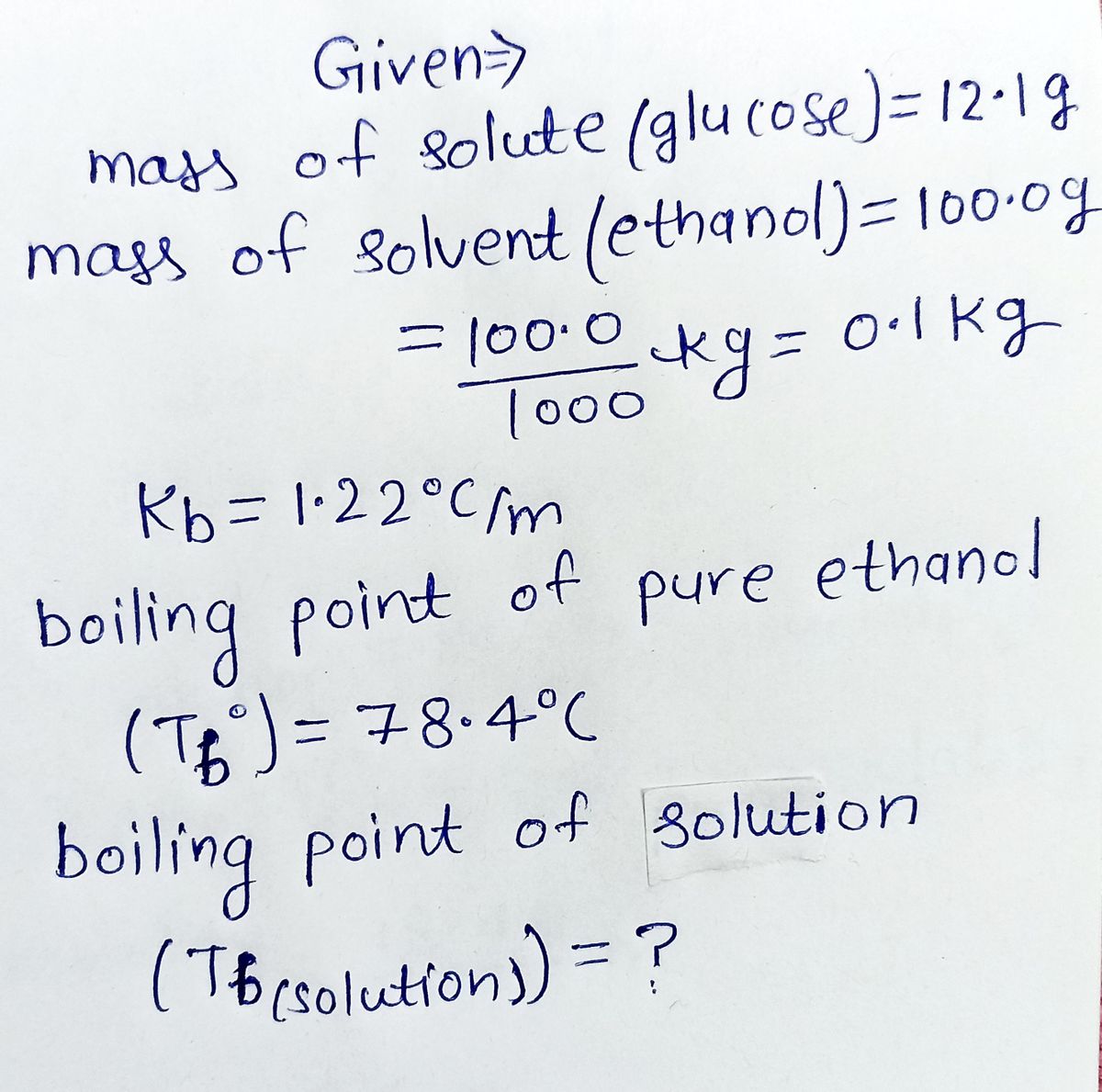
Chemistry
10th Edition
ISBN: 9781305957404
Author: Steven S. Zumdahl, Susan A. Zumdahl, Donald J. DeCoste
Publisher: Cengage Learning
expand_more
expand_more
format_list_bulleted
Concept explainers
Question

Transcribed Image Text:The boiling point of pure ethanol (C₂H5OH, MM = 46.07 g/mol) is 78.4
°C. A solution is made using 100.0 g of ethanol (the solvent) and 12.1
g of glucose (MM = 180.16 g/mol). What is the boiling point of this
solution, in °C? (Kb of ethanol is 1.22 °C/m)
Expert Solution
arrow_forward
Step 1

Trending nowThis is a popular solution!
Step by stepSolved in 3 steps with 3 images

Knowledge Booster
Learn more about
Need a deep-dive on the concept behind this application? Look no further. Learn more about this topic, chemistry and related others by exploring similar questions and additional content below.Similar questions
- A certain liquid X has a normal boiling point of 141.90 °C and a boiling point elevation constant K, = 1.32 °C·kg•mol¯. Calculate the boiling point of a solution made of 23.g of urea (CH,N,O) dissolved in 700. g of X. Round you answer to 5 significant digits. x10 ?arrow_forwardA solution of toluene in 601 g of cyclohexane has a boiling point of 90.3 °C. How many moles of toluene are in the solution? (For cyclohexane Kb = 2.92 °C/m, Tb = 80.9 °C)arrow_forwardcan u help me w this questionarrow_forward
- The freezing point of water is 0.00°C at 1 atmosphere. A student dissolves 13.21 grams of sodium chloride, NaCl (58.40 g/mol), in 282.7 grams of water. Use the table of boiling and freezing point constants to answer the questions below. Solvent Formula Kb (°C/m) Kf (°C/m) Water H2O 0.512 1.86 Ethanol CH;CH2OH 1.22 1.99 Chloroform CHC13 3.67 Benzene C6H6 2.53 5.12 Diethyl ether CH3CH,OCH,CH3 2.02 The molality of the solution is m. The freezing point of the solution is °C.arrow_forwardInsulin is a protein that regulates carbohydrate metabolism by decreasing blood sugar levels. A deficiency in insulin leads to diabetes. An aqueous solution of insulin contains 0.360 moles of insulin in 50.0 g water. What is the boiling point of this solution? Water has a kb = 0.512 °C/m and the molar mass of insulin is 5730 g/mol.arrow_forwardA certain liquid X has a normal boiling point of 129.10 °C and a boiling point elevation constant K₁=0.95 °C-kg-mol¯¹. Calculate the boiling point of a solution made of 58.g of benzamide (C₂H₁NO) dissolved in 400. g of X. Round your answer to 4 significant digits. [°C x10 X Śarrow_forward
- The boiling point of pure ethanol is 78.4 °C. A solution is made using 100.0 g of ethanol (the solvent) (MM = 46.07 g/mol) and 20.1 g of methanol (MM = 32.04 g/mol). What is the boiling point of this solution? (Kb of ethanol is 1.22 °C/m)arrow_forwardA 83.5 g sample of a nonelectrolyte is dissolved in 250.1 g of water. The solution is determined to have a boiling point of 102.3 °C. What is the molar mass of the compound? (Kb for water is 0.510 °C/m).arrow_forwardA certain liquid X has a normal boiling point of 117.90 °C and a boiling point elevation constant K,= 1.09 °C·kg'mol Calculate the boiling point of a solution made of 95.g of sodium chloride (NaCl) dissolved in 900. g of X. Round you answer to 4 significant digits.arrow_forward
- What is the boiling point of a solution prepared by dissolving 37.5 g of glucose (C6H12O6, MW=180.16g/mol) in 750 g of ethanol (CH3CH2OH, MW=46.07g/mol)? Kb 1.22°C/m, boiling point of pure ethanol=78.24°C? ATb=ikbm 78.56°C 70.57°C 77.91°C 85.91°Carrow_forwardAt a certain temperature the vapor pressure of pure water is measured to be 233. mmHg. Suppose a solution is prepared by mixing 131. g of water and 71.8 g of acetic acid (HCH,CO2). Calculate the partial pressure of water vapor above this solution. Round your answer to 3 significant digits. Note for advanced students: you may assume the solution is ideal. | mmHg x10arrow_forwardHow many grams of glucose (molar mass = 180.16 g mol1) must be dissolved in 255 g of water to raise the boiling point to 102.56 °C? Mass of glucose = g Use correct number of significant digits;arrow_forward
arrow_back_ios
arrow_forward_ios
Recommended textbooks for you
 ChemistryChemistryISBN:9781305957404Author:Steven S. Zumdahl, Susan A. Zumdahl, Donald J. DeCostePublisher:Cengage Learning
ChemistryChemistryISBN:9781305957404Author:Steven S. Zumdahl, Susan A. Zumdahl, Donald J. DeCostePublisher:Cengage Learning ChemistryChemistryISBN:9781259911156Author:Raymond Chang Dr., Jason Overby ProfessorPublisher:McGraw-Hill Education
ChemistryChemistryISBN:9781259911156Author:Raymond Chang Dr., Jason Overby ProfessorPublisher:McGraw-Hill Education Principles of Instrumental AnalysisChemistryISBN:9781305577213Author:Douglas A. Skoog, F. James Holler, Stanley R. CrouchPublisher:Cengage Learning
Principles of Instrumental AnalysisChemistryISBN:9781305577213Author:Douglas A. Skoog, F. James Holler, Stanley R. CrouchPublisher:Cengage Learning Organic ChemistryChemistryISBN:9780078021558Author:Janice Gorzynski Smith Dr.Publisher:McGraw-Hill Education
Organic ChemistryChemistryISBN:9780078021558Author:Janice Gorzynski Smith Dr.Publisher:McGraw-Hill Education Chemistry: Principles and ReactionsChemistryISBN:9781305079373Author:William L. Masterton, Cecile N. HurleyPublisher:Cengage Learning
Chemistry: Principles and ReactionsChemistryISBN:9781305079373Author:William L. Masterton, Cecile N. HurleyPublisher:Cengage Learning Elementary Principles of Chemical Processes, Bind...ChemistryISBN:9781118431221Author:Richard M. Felder, Ronald W. Rousseau, Lisa G. BullardPublisher:WILEY
Elementary Principles of Chemical Processes, Bind...ChemistryISBN:9781118431221Author:Richard M. Felder, Ronald W. Rousseau, Lisa G. BullardPublisher:WILEY

Chemistry
Chemistry
ISBN:9781305957404
Author:Steven S. Zumdahl, Susan A. Zumdahl, Donald J. DeCoste
Publisher:Cengage Learning

Chemistry
Chemistry
ISBN:9781259911156
Author:Raymond Chang Dr., Jason Overby Professor
Publisher:McGraw-Hill Education

Principles of Instrumental Analysis
Chemistry
ISBN:9781305577213
Author:Douglas A. Skoog, F. James Holler, Stanley R. Crouch
Publisher:Cengage Learning

Organic Chemistry
Chemistry
ISBN:9780078021558
Author:Janice Gorzynski Smith Dr.
Publisher:McGraw-Hill Education

Chemistry: Principles and Reactions
Chemistry
ISBN:9781305079373
Author:William L. Masterton, Cecile N. Hurley
Publisher:Cengage Learning

Elementary Principles of Chemical Processes, Bind...
Chemistry
ISBN:9781118431221
Author:Richard M. Felder, Ronald W. Rousseau, Lisa G. Bullard
Publisher:WILEY